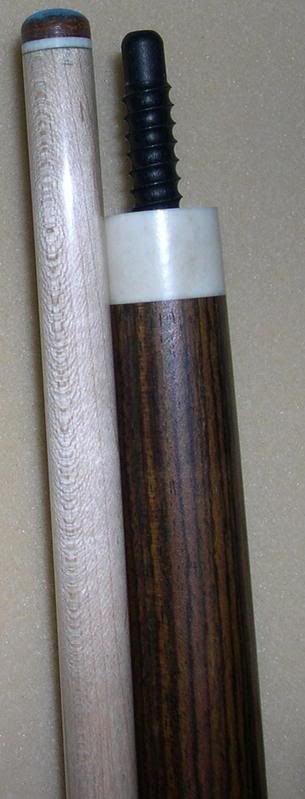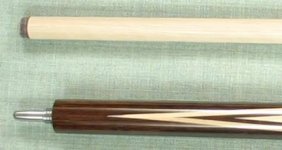I've heard over the past year or so on the forum that some people play with no ferrule and really like it. What are the pros and cons of having just a tip and no ferrule? Also is it acceptable in higher level tournaments?
You are using an out of date browser. It may not display this or other websites correctly.
You should upgrade or use an alternative browser.
You should upgrade or use an alternative browser.
Is no ferrule OK?
- Thread starter Hierovision
- Start date
I'm just too much of a traditionalist to try it. I'm just now starting to accept the shorter ferrules. I personally see no benefit from it as I believe there wouldn't be a difference in hit or playability when compared to a very short, soft ferrule with a large 5/16 id. 
Hierovision said:I've heard over the past year or so on the forum that some people play with no ferrule and really like it. What are the pros and cons of having just a tip and no ferrule? Also is it acceptable in higher level tournaments?
A shaft without a ferrule has a totally different hit than a cue with one. The hit is much more stiff feeling, and also more like shooting with a one cue. The Brunswick cues made in the 1800's to the early 1900's did not have a cue point or what is now called a ferrule. I have a number of these cues on hand, and they appear no worst for wear, except in most cases the shafts are around 13.50mm or larger at the tip. With the current shaft tip size preffered by most peoiple today at 13mm or less I suspect that a pad could be used before tip installation like some people preffer for Ivory ferrules. I think this would give the end of the shaft a little more protection and still achieve a similar if not exact hit as without the pad.
Hope this helps!!!
Sheldon,
How was the hit? Could you draw the cue ball OK?
thanks
John
How was the hit? Could you draw the cue ball OK?
thanks
John
It hit great, and I had no problems drawing the cueball.Ridge Runner said:Sheldon,
How was the hit? Could you draw the cue ball OK?
Hierovision said:I've heard over the past year or so on the forum that some people play with no ferrule and really like it. What are the pros and cons of having just a tip and no ferrule? Also is it acceptable in higher level tournaments?
I have a jump and break cue with no ferrule using a G10 tip. Ok there is a ferrule. I just made the tennon on the ferrule 5/16 and threaded just opposite a regular ferrule. Then glued it together. This gave additional strength to the wood. It worked great and looks like no ferrule was used. The only down side is that if you tried to replace the tip and didn't know what you had you will wreck the shaft.
good luck, jimbo
I wouldn't want the wood to split on hard shots... what would be an acceptable ferrule size? I'm thinking something shorter than 4/10th's if possible... would a hard or soft ferrule material be better in this case? If it's soft it would absorb more of the impact right?
I'm just going to get it done... might as well try it out.
I'm just going to get it done... might as well try it out.

My first one, no probs except it got ugly. lol
Hierovision said:I wouldn't want the wood to split on hard shots... what would be an acceptable ferrule size? I'm thinking something shorter than 4/10th's if possible... would a hard or soft ferrule material be better in this case? If it's soft it would absorb more of the impact right?
I'm just going to get it done... might as well try it out.
No the wood won't split. I tried my with various type of shot. Even a 6 feet draw shot.
The only thing is that it has a more stiffer feel to it.
JoeyInCali said:
My first one, no probs except it got ugly. lol
What wood is that? Where the photo of the whole cue...
is it oil finish... very rugged..
In Russia many top-players count that ferrule eats part of feedback therefore traditionally cues for Russian billiards make without ferrule.

Or establish very short ferrule 8-10мм (0.3"-0.4") long. Balls in Russian billiards are very heavy (about 270-280 gramme ) but the fiber under tip not bad protects end face of shafts from cracks. Feedback is transparent but it is necessary to watch very carefully that the tip has been well pasted to an end face, differently there is a danger that cracks at an end face of shaft will appear.

Or establish very short ferrule 8-10мм (0.3"-0.4") long. Balls in Russian billiards are very heavy (about 270-280 gramme ) but the fiber under tip not bad protects end face of shafts from cracks. Feedback is transparent but it is necessary to watch very carefully that the tip has been well pasted to an end face, differently there is a danger that cracks at an end face of shaft will appear.
http://s2.photobucket.com/albums/y12/joeyincali/?action=view¤t=stix3.jpgicem3n said:What wood is that? Where the photo of the whole cue...
is it oil finish... very rugged..
Bocote. Mixed finish. It's my house cue. I've cleaned it up a little since.
My son got this idea a year or so ago that he was going to eliminate every part on a cue that he could and see how it felt, and only add things to the cue as he saw they needed it. He left off the butt plate and rubber bumper. He made his joint without rings or insert. He glued a tip right on the end of the wood. Well I told him the negatives would be he would split both ends of the shafts and the end of the butt would crack. Well he eventually proved me right on the shaft. He splintered the ends of a shaft or two and cracked a joint or two. He has not cracked the end of the butt as not having a bumper there has made him quit slamming it into the floor when he misses. So now he is playing with a shaft that has a fiber pad like Sheldon's picture above and has not broken it and he has a pretty powerful stroke. So he hits the ball much harder than most. He thinks it is 99% as good of a feel as not having any pad or ferrule and it is holding up. One thing I have noticed on the ones he has put out there is that the chalk gets the wood real dirty behind the tip and some have that worn in ring into the wood that you see on some ferrules. It seems to groove it out easier because wood is softer than plastic.
Last edited:
Dmitry, did you try to make pool shafts with very short/no ferrule too? Why did you decide to use a normal ferrule on your pool cues? Since I like your cues especially for their very stiff hit, I was wondering, if a very short ferrule (or none at all) would make the hit even stiffer 
